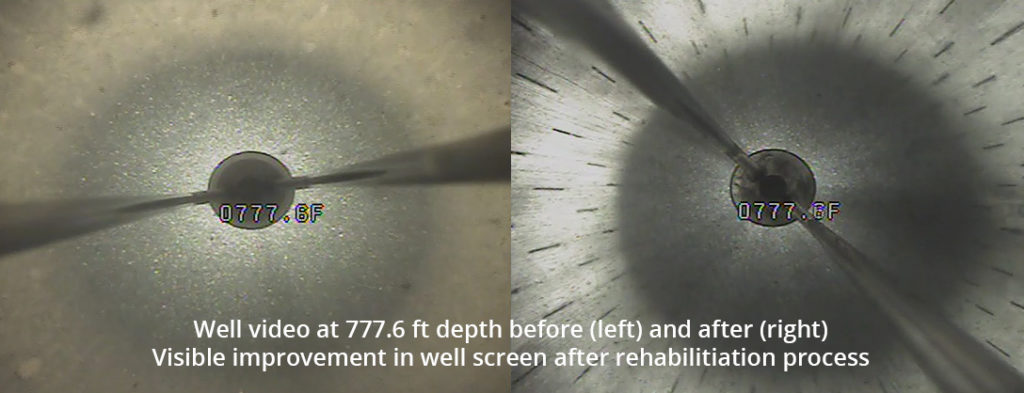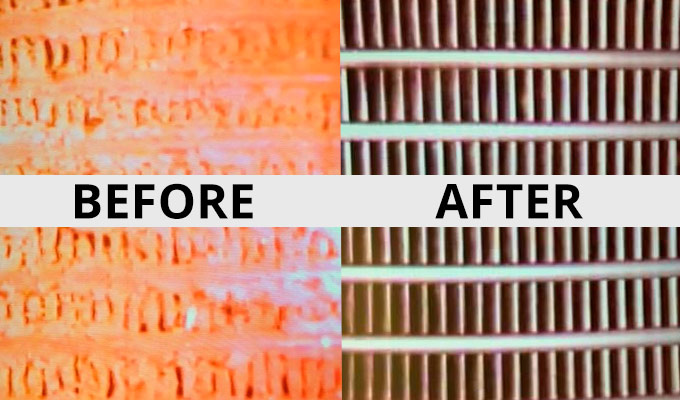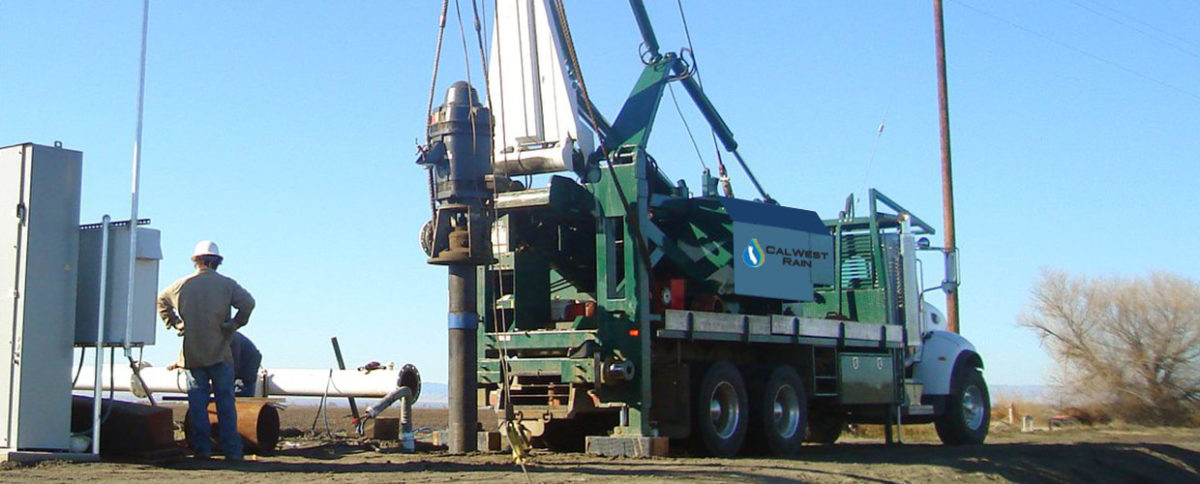As water wells age, the rate at which water may be pumped (commonly referred to as the well yield, flow, or performance) tends to decrease, especially in wells that were not properly developed when first drilled. This article briefly describes common well problems and discusses rehabilitation measures.
Water Well Maintenance
Water wells require regular maintenance to ensure adequate water flow and continued water quality. Every 1-3 years water quality testing is recommended for bacteria, total dissolved solids, and land uses occurring or expected to occur within sight of the well. Additionally, if there are unusual stains, tastes, or odors in water, seek testing that will help identify the source of these symptoms.
Water wells should also be inspected annually for obvious signs of damage or contamination. Additionally, be sure the area within 100 feet around the well is clear of debris or items that might pollute the water supply.
It’s also recommended that you get your wells professionally inspected by a water well contractor at least every ten years. Furthermore, copies of all records related to the history of each well should be maintained:
- Water well completion report or log (if you have it) which should include information such as water well depth, date drilled, construction (including casing specifications, grouting, and screen), and water well yield or flow rate in gallons per minute (gpm)
- Water quality test reports
- Past inspection reports, including video inspections
- Invoices for work done by water well contractors (including pump replacement and maintenance)
- Well equipment makes/models, warranties, invoices, and manuals
Most of these items should be available by contacting the drilling contractor, well development company, consulting engineer, or the geologist.
Well Performance Over Time
As water wells age, the rate at which water may be pumped tends to decrease, especially in wells that were not properly developed when first drilled. A drop or complete loss of water production from a well can sometimes occur even in relatively new wells due to a lowered water level from persistent drought or over-pumping of the well which can dewater the water-bearing zones. More often, reduced well yield over time can be related to changes in the water well itself including:
- Incrustation from mineral deposits
- Bio-fouling by the growth of microorganisms
- Physical plugging of the “aquifer” (the saturated layer of sand, gravel, or rock through which water is transmitted) by sediment
- Sand pumping
- Well screen or casing corrosion
- Pump wear or damage
Water Well Rehabilitation
Measures taken to correct these problems are referred to as well rehabilitation or restoration. A successful well rehabilitation will maximize the flow of water from the well and minimize pumping costs. The chances for successful rehabilitation are dependent on the cause(s) of poor well performance and the degree to which the problem has progressed.
Upon noticing the loss of performance in your well have a professional water well contractor inspect your well, preferably with a specialized downhole camera or video equipment.
A common measure of well performance (or capacity) is referred to as the “specific capacity” which is defined as the pumping rate (gallons per minute) divided by the drawdown or increased depth to water during pumping (in feet).
Generally, a decrease of 25% or more in well yield indicates that rehabilitation is in order. Delaying rehabilitation procedures can significantly increase costs and in some cases make rehabilitation impossible.
To detect deterioration of well performance, you must have a point of reference. Often this reference is the original well construction and pump test data which are normally supplied to you by the well driller (well completion report) or well log when the well was installed and developed. However, even if you do not have this information, significant changes in your well’s performance are also a warning sign. Major changes in any of the following well characteristics are an indication that your well or pump needs attention:
- Decreased pumping rate
- Decreased water level
- Decreased specific capacity
- Increased sand or sediment content in the water (cloudiness)
- Decreased total well depth
Well Rehabilitation Methods
The most common rehabilitation methods for water wells include one or more of the following treatments:
- Chemicals/acids to dissolve obstructing materials in the well
- AirShock® the well with high-pressure gas (pulsing shock waves and oscillating gas bubbles)
- Physical/mechanical methods (i.e. brushes, pressure jetting, surging, etc.)
- A combination of several methods

[IMAGE: Well video images showing fouled (before) and cleared (after) well screen]
Sometimes contractors will use a combination of these methods depending upon the reason(s) for the decrease in well performance.
Reduced Yield from Incrustation or Bio-Fouling
Chemical and biological incrustation are common causes of reduced well performance. Incrustations are physical obstructions that develop on well screens and rock fractures or openings delivering water to the well screen or borehole.
In severe cases, the obstructions to flowing water can render the well useless. Major forms of incrustations can occur from build-up of calcium and magnesium salts, iron and manganese compounds, or plugging caused by slime producing iron bacteria or other similar organisms (bio-fouling).
Treatment of Well Incrustation
The principal means used for rehabilitation of chemical incrustation problems involves the use of strong acid solutions to dissolve incrusting materials. These acids are typically placed in the well for 24-48 hours for optimal performance.
Once loosened or dissolved, the incrusting materials are pumped from the well with the acid solution for disposal. The type of acid to be used, its form (liquid, granular, pelletized), the procedures used to introduce and agitate the acid solution, and the severity of incrustation all play a part in determining the success of acid treatment. It is common for acid-treated older wells to completely recover or even exceed the original well yield assuming any material dislodged by the acid is properly removed from the well.
While acid treatment methods for incrustation removal are very effective, physical agitation methods like AirShock® and mechanical brushing are often used in conjunction with acid treatment to improve results.
Treatment of Bio-Fouling
The primary cause of bio-fouling, or biological clogging, of well screens and rock fractures is attributed to iron bacteria. These and other similar bacteria create a slimy, voluminous “biomat” that plugs or clogs the well screen.
Rapid growth of these bacteria can quickly clog well screen pores and render a well virtually useless in a matter of months. Once iron bacteria become established in a well, they can be extremely difficult to eradicate.
Treating iron bacteria colonies in water wells is often a perpetual process that seeks to maintain well performance at an acceptable level. In general, chemical means of control are most effective. However, best results are achieved when chemical bactericides are used in conjunction with physical agitation of the borehole water to remove the biological residue.
Chemical treatment of iron bacteria problems may not be effective without subsequent agitation of the well water. Turbulent flow causes greater surface area exposure of slime growths to the chemical solution and assists in dislodging obstructions.
Since precipitation of iron in the bacteria biomatting contributes to clogging of flow spaces, rehabilitation results are usually improved when acid treatments are alternated with bactericide treatments.
Failure Caused by Physical Plugging and Sand Pumping
A portion of the loss in well performance over time can often be attributed to the slow migration of fine particles from the aquifer toward the borehole and into the well screen. In some cases, the screen itself can become clogged. To prevent pump damage, the replacement of a deteriorating screen is frequently a good decision. There are several reasons for sediment plugging including:
- Improper well design (poor screen placement, slot design, etc.)
- Insufficient or no well development during the initial well construction
- Removal of aquifer formation cementing materials holding sands together
- Screen and/or casing corrosion
- Over pumping of the well beyond its designed capacity
Treatment of Physical Plugging
The most important preventative measure to avoid physical plugging is proper well development during the initial construction. Adequate well development will stabilize the aquifer material so that subsequent pumping from the well will not result in excessive sediment removal. Removal of fine silt and clay particles introduced in some drilling fluids, or which naturally occur in certain kinds of aquifers, can only be accomplished with the use of chemical treatments.
As with other chemical rehabilitation treatments, agitation of the chemical into and out of the aquifer formation is crucial to the success of the operation. This agitation may be provided by a surge plunger, compressed air, well pump, or a high-velocity jet. The use of a high-velocity jet is generally recognized as the most effective means of agitation. When water from the well is re-circulated for jetting, sediment should be removed prior to reuse. Continuous removal of dislodged sediment, as done in a recirculating jet operation, gives the best results as the cleaning solution is able to penetrate more deeply into the aquifer medium.
Failure Caused by Corrosion
Corrosion of metal well casing and other components can seriously reduce the useful life of a well in several ways.
Corroded and enlarged well screen holes may lead to sand pumping, which in turn results in abrasive deterioration of pump parts and enlarged screen openings leading to excessive sediment velocities.
In this case, abrasive materials carried in high-velocity flows can lead to erosion of the screen openings. A screen or well casing that has undergone significant corrosive deterioration may collapse altogether. A final negative impact of well corrosion is that water from a seriously affected well may be such low quality that uses are limited.
Treatment of Well Corrosion
The best way to avoid or fix corrosion problems is to select appropriate corrosion-resistant casing and screening materials. Carbon steel screens are less expensive than stainless steel but are more susceptible to corrosion. Keep in mind that excessive acid-rehabilitation well treatments can also significantly accelerate general corrosion.
Failure Caused by Pump Damage
Water well pump damage is usually the result of one or more of the following factors:
- Pumping of abrasive sand or sediment
- Corrosion of pump parts
- Excessively high operating temperatures
- Pump cavitation
Abrasive deterioration resulting from sand pumping is the leading cause of pump failure.
Excessive sediment concentrations in well water can be brought about by inadequate initial well development, absence of a well screen in a loose rock formation, oversized screen openings, excessive well screen entrance water velocities resulting from undersized openings, or well screen corrosion.
Treatment of Pump Damage
Usually, a pump will show some evidence that maintenance is in order. Most major causes of pump failure are related to mechanical problems such as bearings, stuffing boxes, impellers, and pump bowl assemblies. Maintenance, repair and replacement of the pump and motor parts should be in accordance with the manufacturer’s recommendations by an experienced well or pump contractor.
Correction of recurring sand pumping problems is in some cases cost-prohibitive. Total well replacement may in the long run be more economical than rehabilitation of a severely deteriorated well. This is especially true of shallow wells.
However, when drilling a new well is not feasible, it is sometimes possible to extract and replace a severely damaged well screen in the existing well. Installation of a smaller diameter screen (also known as a liner) inside the original well screen has also been used as a remedy. Various devices can also be installed to even out or reduce the flow of water entering the well and thus reduce the potential for sand pumping.
Summary
If your well begins to demonstrate the symptoms of poor performance, don’t delay in contacting a professional water well contractor. The sooner that they can inspect the well to find the problem and treat it, the more likely you are to have a successful water well rehabilitation.

[IMAGE: Well screen before and after comparison following AirShock® treatment]
About Cal-West Rain
Since 1989, Cal-West Rain has served growers and ranchers in California’s San Joaquin Valley and the Central Coast. With branches in Kerman, Paso Robles and Hanford, Cal-West Rain offers a comprehensive line of products and services for agricultural irrigation, wells, pumps, filtration systems and automation. Our well-related services include:
- Well development (1,000 hp capacity)
- Well inspections (video and more)
- Well rehabilitation (chemical, AirShock®, mechanical agitation)
- Pump repair, rebuilds and installation
- Electrical repairs and services
- Electric pump motor repairs, rebuilds and installation
Learn more about Cal-West Rain at www.calwestrain or call us at 559-846-5326.

